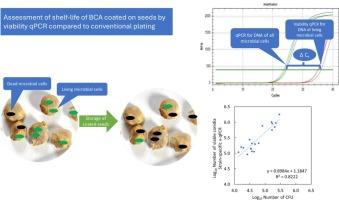种包衣微生物防菌剂在种子贮藏期间的存活
IF 3.4
2区 农林科学
Q2 BIOTECHNOLOGY & APPLIED MICROBIOLOGY
引用次数: 0
摘要
通过在种子上施用拮抗剂对种子病原菌和土壤病原菌进行生物防治是化学种子处理的一种替代方法。在种子加工、储存和分配的各个步骤中,被包膜微生物的存活对于有益真菌或细菌在种子上的利用是必不可少的。为了解不同作物包衣种子在贮藏过程中不同微生物群代表的生存潜力和生存变异性,进行了一项研究。接种菌在芸苔、洋葱、菠菜和多年生黑麦草种子上的存活率采用镀膜法检测,部分包被种子采用qPCR法检测。通过菌株特异性或属属真菌活力qPCR对不同种子批上包被的枝孢枝孢子H39的分生孢子进行分析,发现每粒种子的CFU计数与估计的活孢子数密切相关。对于溶菌酶原3.1 T8, qPCR结果显示包被种子上细胞存活。然而,在色氨酸大豆琼脂上只能产生少量菌落。非包衣种子的通用真菌和细菌qPCR和活力qPCR分析表明,只有一部分种子微生物群(通常不到10%)是有活力的。接种菌包被在种子上并保存3 - 6个月的存活率因施用微生物群、接种菌配方和进行实验的实验室而异。从所获得的结果可以得出结论,有一个很好的潜力,以改善经常设想的低存活率接种在种子上。改良的菌株选择、改良和适应的种子加工技术,以及发展微生物种子加工方面的专业知识,将允许使用更广泛的真菌和细菌类群。生存力qPCR技术的应用将支持这一发展,作为一种快速可靠的工具来监测微生物接种在种子上的存活。本文章由计算机程序翻译,如有差异,请以英文原文为准。

Survival of seed-coated microbial biocontrol agents during seed storage
Biological control of seedborne pathogens and soilborne seedling pathogens through antagonists applied on seeds is an alternative to chemical seed treatments. The survival of coated microorganisms during the various seed processing, storage and distribution steps is essential for the use of beneficial fungi or bacteria on seeds. A study was done to gain insight into the survival potential and variability in survival of representatives of different microbial groups during storage of coated seeds of different crops. Survival of inocula on seeds of Brassica, onion, spinach and perennial ryegrass was tested by plating and for a subset of coated seeds by viability qPCR. A close correlation was found for CFU counts per seed and the estimated number of viable conidia based on strain-specific or generic fungal viability qPCR for conidia of Cladosporium cladosporioides H39 coated on various seed lots. For Lysobacter enzymogenes 3.1 T8, viability qPCR showed survival of cells on coated seeds. However, only few colonies were produced on Tryptone soy agar. Generic fungal and bacterial qPCR and viability qPCR assays with non-coated seeds indicated that only a proportion of the seed microbiota, frequently less than 10 %, are viable. Survival of inocula coated on seeds and stored for three to six months differed between applied microbial groups, formulation of inocula and between laboratories conducting the experiments. From the obtained results it can be concluded that there is a promising potential to improve the often envisaged low survival of inocula coated on seeds. Improved strains selection, improved and adapted seed processing technologies, and developing expertise in microbial seed processing will allow the use of a broader range of fungal and bacterial groups. The application of viability qPCR will support this development as a fast and reliable tool to monitor the survival of microbial inocula coated on seeds.
求助全文
通过发布文献求助,成功后即可免费获取论文全文。
去求助
来源期刊

Biological Control
生物-昆虫学
CiteScore
7.40
自引率
7.10%
发文量
220
审稿时长
63 days
期刊介绍:
Biological control is an environmentally sound and effective means of reducing or mitigating pests and pest effects through the use of natural enemies. The aim of Biological Control is to promote this science and technology through publication of original research articles and reviews of research and theory. The journal devotes a section to reports on biotechnologies dealing with the elucidation and use of genes or gene products for the enhancement of biological control agents.
The journal encompasses biological control of viral, microbial, nematode, insect, mite, weed, and vertebrate pests in agriculture, aquatic, forest, natural resource, stored product, and urban environments. Biological control of arthropod pests of human and domestic animals is also included. Ecological, molecular, and biotechnological approaches to the understanding of biological control are welcome.
 求助内容:
求助内容: 应助结果提醒方式:
应助结果提醒方式:


